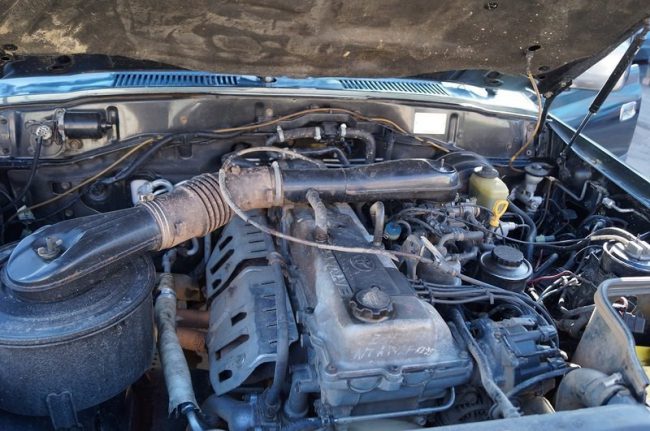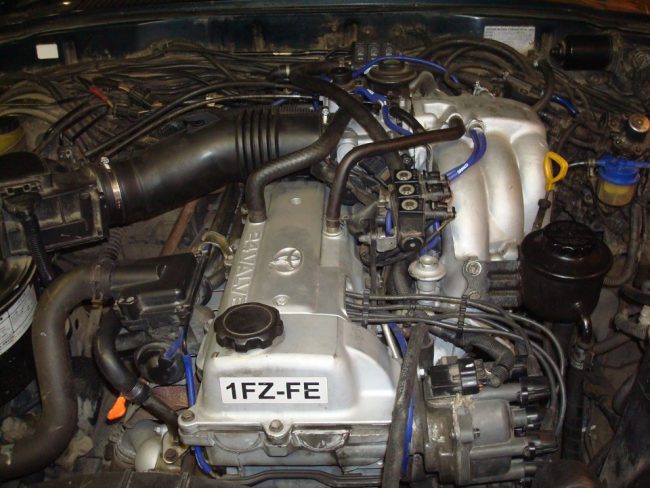
Toyota 1FZ-F engine
Content
In 1984, Toyota Motor completed the development of a new 1FZ-F engine designed to power the popular Land Cruiser 70 SUV, then installed on Lexus vehicles.

The new motor replaced the aging 2F and was produced until 2007. Initially, the task was to create a reliable, high-torque engine, well adapted for movement over rough terrain. Toyota engineers managed to complete this task to the full extent. Several modifications of this power unit were produced.
- FZ-F version with a 197 hp carburetor power system. at 4600 rpm. For some countries, derated up to 190 hp was produced. at 4400 rpm motor option.
- Modification 1FZ-FE, launched in the second half of 1992. Distributed fuel injection was installed on it, due to which the power increased to 212 hp. at 4600 rpm.
The Land Cruiser 70 with the new engine proved to be a model of reliability and durability and was delivered to many countries of the world.
Design features of FZ engines
The 1FZ-F power unit is an in-line six-cylinder carburetor type engine. The ignition system is electronic, with a mechanical distributor. The cylinder head is made of aluminum alloy. It has two camshafts, each of which drives 12 valves. Total - 24, 4 for each cylinder. The timing chain drive, with a hydraulic tensioner and the same damper. There are no hydraulic lifters, periodic adjustment of valve clearances is required.

At the bottom of the block is an aluminum oil sump. The oil pan is made of durable steel, which protects it from contact with the ground, which is fraught with driving over rough terrain.
Lightweight aluminum alloy pistons with high heat resistance are installed in the cast-iron cylinder block. The top compression ring is made of stainless steel. The lower and oil scraper are made of cast iron. There is a recess on the bottom of the piston that prevents the valve and piston from contacting when the timing chain breaks. The compression ratio of the engine is 8,1:1, so the power plant does not require the use of high-octane gasoline.
Such design solutions made it possible to create a low-speed engine with a smooth, "tractor" thrust in almost the entire speed range, adapted for long-term operation in difficult road conditions. At the same time, a car with this internal combustion engine does not feel like a foreign body on the highway either. The 1FZ-F power unit existed on the assembly line until 1997.
The 1FZ-FE motor was put into production at the end of 1992. On it, instead of a carburetor, distributed fuel injection was used. The compression ratio was increased to 9,0:1. Since 2000, the non-contact electronic ignition system with mechanical distributor has been replaced by individual ignition coils. In total, 3 coils were installed on the motor, each serving 2 cylinders. This scheme contributes to better sparking and increased reliability of the ignition system.

The cooling system is carefully thought out, and provides an operating temperature in the range of 84 - 100 ºC. The engine is not afraid of overheating. Even prolonged movement in low gears in hot weather does not lead to the engine going beyond the set temperature. The water pump and alternator are driven by separate wedge-shaped belts, each equipped with tensioners. Adjustment of tension rollers of these belts is mechanical.
The 1FZ series engines have proven themselves from the very best side in terms of reliability and durability. The designers did not make any miscalculations in the development of the internal combustion engine, and the technologists competently embodied everything in iron. The power unit has made a significant contribution to the reputation of the Toyota Land Cruiser 70, which is famous for its indestructibility. Engine Advantages:
- simplicity and reliability of the design;
- mileage to overhaul with proper maintenance - at least 500 thousand km;
- high torque at low speeds;
- maintainability.
The disadvantages include high fuel consumption, which is 15–25 liters of A-92 gasoline per 100 km. With these motors, a characteristic drawback of Toyota engines began, and still exists, is pump leakage. In such cases, it is recommended to replace the assembly with an original assembly.
In addition, relatively frequent oil changes are required. It is changed every 7–10 thousand km, depending on the operating modes. Recommended oil is synthetic 5W-30, 10W-30, 15W-40. Crankcase volume - 7,4 liters.
Technical specifications
The table shows some of the technical characteristics of the power units of the 1FZ series:
| Engine make | 1FZ-F |
|---|---|
| Supply system | Carburetor |
| Number of cylinders | 6 |
| Number of valves per cylinder | 4 |
| Compression ratio | 8,1:1 |
| Displacement, sm3 | 4476 |
| Power, hp / rpm | 197 / 4600 (190 / 4400) |
| Torque, Nm / rpm | 363/2800 |
| Fuel | 92 |
| Resource | 500+ |
Tuning possibilities
The 1FZ-FE engine does not like high revs too much, so increasing them to achieve higher power is irrational. Initially, a low compression ratio allows you to install a turbocharger without altering the piston group.
Especially for this motor, the tuning company TRD has released a turbocharger that allows you to increase power up to 300 hp. (and more), sacrificing marginally durability.
Deeper forcing requires replacing the crankshaft, which will increase the working volume to 5 liters. Paired with an overpressure turbocharger, this alteration provides a heavy car with the dynamics of a sports car, but with a significant loss of resource and high material costs.
Opportunity to purchase a contract engine
Offers on the market are quite diverse. You can purchase an engine, starting from an amount equal to 60 thousand rubles. But it is difficult to find an internal combustion engine with a decent residual resource, since such motors have not been produced for a long time and have a significant output.

